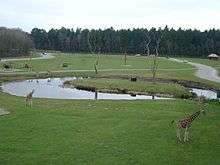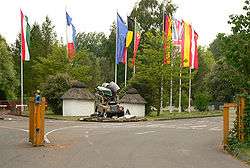Serengeti Park
|
Entrance | |
| Location | Hodenhagen, Germany |
|---|---|
| Coordinates | 52°44′44″N 9°37′0″E / 52.74556°N 9.61667°ECoordinates: 52°44′44″N 9°37′0″E / 52.74556°N 9.61667°E |
| Owner |
Serengeti-Park Hodenhagen GmbH Am Safaripark 1 29693 Hodenhagen |
| Opened | 1974 |
| Area | 200 ha (490 acres) |
| Website | www.Serengeti-Park.de |
The Serengeti Park in Hodenhagen, Lower Saxony, is a zoo and leisure park in North Germany.
History
In 1972, the Duke of Bedford had the idea of building the largest safari park in Europe with partners from America. In 1974, this plan was realised and, since then, the Sepe family has run the park. When it opened the investors had spent about 20 million deutschmarks. In 1983, the park was extensively renovated. Over time, in addition to Animal World, it has created new zones known as Monkey World, Water World, and Leisure World. In 1996, Serengeti Park was the first to release into the wild white rhinos bred in Europe.
In 1999, the first baby monkey jungle in the world was opened where children up to 8 years old enter a height-limited area directly to see different small species of monkey. Adults may only use the walkway running parallel to it. In 2003, Serengeti Park admitted its first white tiger.
In 2004, Serengeti Park received permanent recognition as a zoological garden in accordance with current EU guideline 99/22/EG and §45 of the north German nature reserve law and on the basis of a LANA inspection. 23 March 2006 saw the first African elephant calf to be born in north Germany for 30 years.
Zones
Serengeti Park is divided into four zones: Animal World (Tierland), Water World (Wasserland), Monkey World (Affenland), and Leisure World (Freizeitland).
Animal World
Animal World covers an area of 110 hectares (270 acres), has around 1,500 animals living in the open and can be visited by car. Alternatively visitors can use a Serengeti Bus; during feeding times the animals are enticed close to the bus. The zone is divided into 13 sections.
Section 1 known as Afrika 1 contains eland, giraffe, blue wildebeest, waterbuck, oryx, sable antelope, flamingo, and nyala as well as enclosures for spider monkeys and siamang. In Section 2, Scandinavia, reindeer and moose may be seen. Section 3 Europa is home to fallow deer, moufflon, goats, sheep, ducks and geese, dwarf donkeys, and mini ponies. Here visitors may leave their cars and feed and stroke the animals. Common seals can also be observed here in a natural lake.
Next to Section 4 Amerika with its greater rhea, elk, bison and guanacos is Section 5 Russland, in which sika deer, blackbuck and alpaca as well as Amur leopards may be seen. Section 6 Asien features chital, yaks and Père David's deer and also has a gibbon island. Indian wild dogs live in Section 7, lions in Section 8, and tigers in Section 9. Section 10 is home to animals from several continents including American black bear, baboons, ostriches, onagers, Bactrian camels, and Barbary sheep


Emus and kangaroos can be seen in Section 11, Australien. Section 12 Afrika 2 has white rhino, Watusi cattle, zebra, lechwe and dromedaries. Section 13 includes an enclosure with African elephants. The biggest attraction here is elephant calf Bou Bou born on 23 March 2006 at Serengeti Park.
Since early 2003, four white tigers have been added to Animal World in a new enclosure. The tigers were formerly part of Circus Barum and were given to Serengeti Park by Gerd Siemoneit-Barum on being retired. In December 2006, the first successful breeding of a tiger was achieved with the birth of tiger cub Paul.
Water World
Water World can be visited on foot (as can Monkey World and Leisure World). In Water World everything revolves around water. Here, in addition to animals like geese, swans, and ducks there are also attractions like a 600 m long log flume, a giant pirate ship, and the African village, Kongo.
Monkey World
Twenty different species of monkey live in Monkey World (for example: Barbary macaques, squirrel monkeys, mantled guereza, white-headed lemurs, tufted capuchins, ring-tailed lemurs, white-headed capuchins, green monkeys, patas monkeys, grey langurs, lar gibbons, cottontop tamarins, common marmosets, chimpanzees and gorillas), some in walk-through enclosures. The Jungle Safari Tour also begins in Monkey World. This open-top bus tour takes in part of Animal World in Safari style and also negotiates an off-road section with special effects.
Leisure World
In Leisure World there are over 40 different fairground rides suitable for children and adults, such as the roller coaster, Ferris wheel, and fitness trail. The Serengeti restaurant, Zanzibar, is also located in Leisure World.
Shows
Four shows take place daily in Serengeti Park:
- Feeding of the monkeys in the Amboseli Reserve (Monkey World)
- African Magic Show (magic and juggling in Water World)
- Punch and Judy Show (Water World)
- Zambesi Water Show (Leisure World)
Accommodation
Since 2007, it has been possible to stay at Serengeti Park. Eighty holiday homes with a total of 300 beds are available in the Serengeti Safari Lodge. In addition, there is a conference room with around 200 seats.
External links
| Wikimedia Commons has media related to Serengeti-Park Hodenhagen. |
